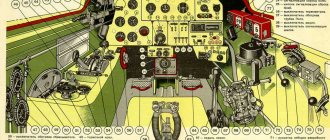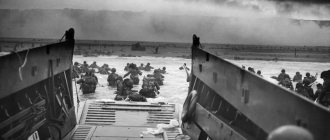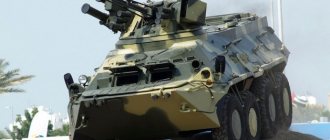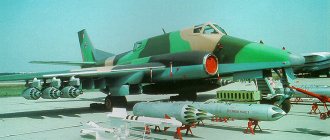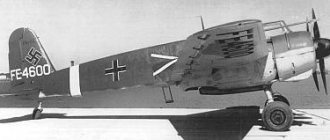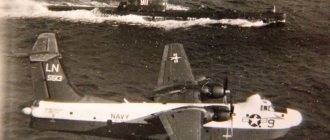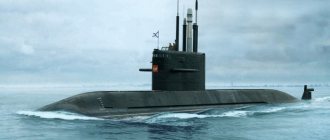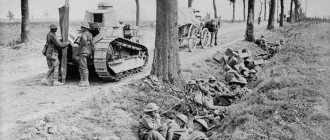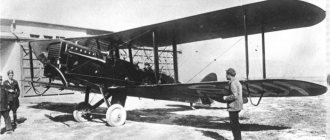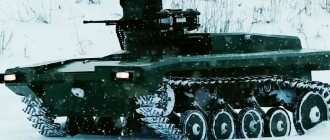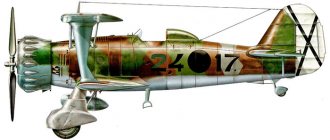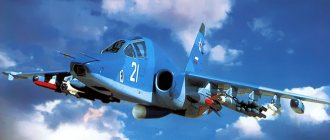“ Brief information : The famous Soviet attack aircraft Il-2 designed by S.V. Ilyushin, nicknamed the “Black Death”. The history of creation, design and modifications of the most famous attack aircraft of the Second World War"
Il-2 attack aircraft with Sh-37 cannons under the wings
In January 1938, Sergei Vladimirovich Ilyushin approached the USSR government with a proposal to build a two-seat armored attack aircraft developed in his design bureau, which was superior in combat effectiveness to the aircraft created under the Ivanov program.
In 1939-40 Two copies of the aircraft were manufactured, designated BSh-2 (TsKB-55) . However, the acceptance committee did not then pay due attention to the security of the aircraft from the tail section. Defense capability was sacrificed to enhanced armor, cannon armament, and most importantly, to an increased range, by building a single-seat version. The converted aircraft was tested and, under the designation Il-2 , was put into production at three factories at once.
Development and combat use of the Il-2 attack aircraft
The very first battles showed the high efficiency of on-board weapons, the exceptional survivability of the aircraft and the reliability of the armored hull. Having a small number of Il-2 attack aircraft, the command used them to strike at concentrations of enemy armored vehicles, marching columns, at gas stations, and in pre-battle formations.
The practice of combat operation of the Il-2 testified to the successful selection of offensive weapons. Two ShVAK (or VYA) cannons, with a successful approach to the target, made it possible to destroy one or two light tanks from a distance of 300-600 m. A salvo launch of eight RS-82 shells from a distance of 300-400 m was equally effective. Moreover, the demoralizing effect of a missile attack on the enemy was so great that when the Il-2 appeared, the tank crews abandoned their vehicles.
Military equipment and vehicles were hit by bombs of various calibers - weighing 250, 100, 50, 25, 15, 10, 2.5 or 1 kg, depending on the nature of the target. ShKAS machine guns were used to exterminate manpower. Il-2 was one of the few Soviet aircraft that received its own name from the enemy - “Schwarz Tod” (“Black Death”).
Nevertheless, German fighters quickly found the “Achilles heel” of the Il-2. Almost from the first days of the war, the OKB began to receive information about heavy losses of attack aircraft, deprived of fighter cover.
Sturmovik Il-2
Despite good armor protection and maneuverability, the single-seat Il-2s were vulnerable. The enemy fighter mainly approached from behind, from the side, and almost point-blank - from a distance of 10-15 m - shot at the cockpit of the Il-2 pilot from cannons and machine guns. But only in 1942 was S.V. Ilyushin asked to return to the development of a two-seat attack aircraft.
Meanwhile, without waiting for new machines, the flight technical staff of some assault regiments reworked their Il-2s on their own, in field workshops. Part of the canopy behind the pilot's cabin was removed, a cutout was made in the fuselage, onto which a turret, pivot or homemade machine gun mount was mounted.
In addition, attack pilots of single-seat Il-2s began to use tactics of striking ground targets from the so-called “free circle”, which, when enemy fighters appeared, was rebuilt into a closed circle and each aircraft in front was covered by the one following it. Over time, other tactics were developed to combat IL-2 fighters. Experienced pilots, having mastered their aircraft well, could perform aerobatic maneuvers on it and quite successfully conduct a defensive air duel with an enemy fighter.
In October 1942, military tests of the first serial two-seat Il-2 attack aircraft with a BT machine gun began on the Central Front. A decrease in losses from attacks by enemy fighters was noted, as well as an increase in the effectiveness of a combat mission, in which the pilot could concentrate on targeted bombing and shooting. However, now there were approximately 7 killed shooters for every pilot killed.
[edit] Die Sratschen
Like any more or less mass phenomenon, the IL-2 over time gave rise to a bunch of showdowns, from which a lot of goodies can be taken out.
Let's collect the main points of the Olympians:
- Argument: “The plane is so crap that out of 36 thousand, 23.6 did not return home.”
- Answer: “I would look at you if so many anti-aircraft gunners were firing at you. Moreover, 12.4 thousand Gorbatys were lost in battle. The rest flopped on their bellies during landing, got lost in the fog at night, or somehow got lost not in battle.” K.O.’s version: this is the most hellish job: flying over the enemy almost right to the ground and having a greater chance of dying.
- K.O.’s version: it shouldn’t hold such calibers, because after all, this is an airplane, and not a tank in the literal sense. Here it holds fire from the main small arms of the Pihota (rifle bikes, machine guns, machine guns). Moreover, the armor used was heterogeneous, three-layered - viscous malafia between two layers of solid cast iron. Everything that pierced the outer layer was slowed down in the malafia and entered the engine with significantly weakened energy. Well, those Kevlars of yours didn’t exist then.
- K.O's version: it is obvious that with such armor there will be a lot of weight and poor maneuverability.
Further development of the Il-2 attack aircraft
During serial production, the power of the weapons increased. Since 1943, two NS-37 cannons began to be installed under the wing of the aircraft. The effectiveness of destroying armored vehicles has especially increased with the creation of small-sized anti-tank bombs PTAB-2.5-1.5 with cumulative action.
When hitting a target, a bomb weighing 1.5 kg burned through armor up to 70 mm thick. The Il-2 bomb bays could accommodate up to 192 PTAB bombs. Dropped in one pass, from a height of 75-100 m, they hit objects, including almost all tanks, over an area of 15 x 70 m.
In total, during the war years, aviation industry enterprises built 36,163 Il-2 aircraft of all modifications.
Main modifications of the Il-2 attack aircraft
Modifications of the Il-2 attack aircraft
BSh-2 (TsKB-55, DBSh) is a two-seat armored attack aircraft with an AM-35 engine (1350 hp). Mixed design: the front part of the fuselage is an armored hull; the tail part is wooden, laminated from birch veneer and plywood; the wing and tail are made of duralumin. Armament: four wing-mounted ShKAS machine guns and one movable machine gun in the gunner's cockpit, 400-600 kg of bombs. State tests were carried out in April 1940. The speed at the ground is 362 km/h. Two copies were released (No. 1 and No. 2).
TsKB-57 is an experienced armored attack aircraft, converted to install an AM-38 engine (1600 hp). On TsKB-55 No. 1, instead of the gunner’s cabin, a gas tank and a 12-mm armored partition were installed, and a long opaque fairing was located behind the canopy. To improve longitudinal stability, the centering was shifted forward, the wing consoles were given a 5° sweep and the stabilizer area was increased. The armament remained machine gun. Tests were carried out in October 1940. A ground speed of 423 km/h was achieved.
TsKB-55P (cannon) - a modified single-seat TsKB-55 No. 2 with an AM-38 engine. The wing was converted to accommodate two PTB-23 cannons. To improve forward visibility, the engine was lowered down by 175 mm, and the seat and canopy were raised by 50 mm, and the contours of the hood were changed accordingly. To protect the pilot's head, transparent armor and a short transparent fairing were installed at the rear, for the shape of which the aircraft was nicknamed "Humpback". The thickness of the armored hull sheets has been increased. Armament: two 23-mm cannons, two ShKAS machine guns, eight RS-82 shells. After testing in the air, it was decided to replace the guns due to high recoil. The aircraft with installed serial ShVAK cannons received the designation Il-2 in January 1941. In February - March, state tests were carried out, in which a speed of 433 km/h was obtained at the ground. In this form, the car became the standard for the series.
Il-2 single-seat - serial. The first aircraft was produced in March 1941 and met the standard. In April, the new VYa-23 cannon was tested on the Il-2. Armament: two ShVAK cannons (up to 500 rounds) or two VYA-23 cannons (300 rounds), two ShKAS machine guns (1,500 rounds), eight RS-82 shells and 400-600 kg of bombs. The fuel reserves of production vehicles were increased. The flight weight reached 5873 kg. The ground speed was 372-382 km/h. By June 1941, 249 aircraft had been built.
Il-2 M-82 (September 1941) - a backup version with an M-82 engine for uninterrupted production of Il-2 in the absence of AM-38 engines. On the production IL-2, the front part of the armored hull with the engine and all systems was removed. The installed M-82 air-cooled engine was not armored, but was covered with a duralumin hood with a controlled “skirt.” The cabin gas tank was removed, and in its place in the armored hull there was a gunner's cabin with an armored canopy and a 12.7-mm BT machine gun on a pivot mount. The main weapons remained unchanged. A slight decrease in speed was noted - 365 km/h at the ground. Nevertheless, in April 1942, the aircraft passed state tests and was recommended for production, but was not mass-produced.
Characteristics of IL-2
A country:USSRType:StormtrooperYear of issue:1940Crew:2 peopleEngine:1 x AM-38F 1750 hpMaximum speed:405 km/hPractical ceiling:6900 mRange of flight:685 kmEmpty weight:No informationMaximum take-off weight:No informationWingspan:14.6 mLength:11.6 mHeight:No informationWing area:No informationWeapons:2 x 20 mm ShVAK cannon, 1 x 12.7 mm BT machine guns, 2 x 7.62 mm ShKAS machine guns Maximum bomb load: 600 kg on internal sling (with NS-37 guns - 200 kg)
Il-2 with Sh-37 cannons At the end of 1941, an attempt was made to strengthen the armament of the serial single-seat Il-2 with two Sh-37 cannons, instead of two ShVAKs. Due to the large size of the gun and magazine (for 40 shells), it had to be placed under the wing in a bulky fairing. Armament: two ShKAS machine guns, eight RS-82 shells and 200 kg of bombs. A small series has been built.
Il-2 double (beginning of 1942) - a two-seat version with defensive weapons. Minimal changes were made to the fuselage design - a semi-turret installation with a BT machine gun and an unarmored canopy that folds to the right were mounted on the edged cutout in the gargrot. Armament: two VYA-23 cannons, two ShKAS machine guns, eight RS-82 or four RS-132 shells, 400-600 kg of bombs. The flight weight of the vehicle increased by 270 kg. In March 1942, factory tests began. The speed with the AM-38 engine, compared to the single-seat Il-2, decreased by 26 km/h, and the piloting technique remained almost unchanged. The aircraft was put into large-scale production. In October 1942, the two-seat Il-2s took part in combat operations for the first time. Several versions of the gunner's cabin with a machine gun, completely enclosed, were developed.
Il-2 with a blister machine gun mount - experimental version of 1942. Modeled after the Il-2 M-82 aircraft, the gunner's cabin with a BT machine gun was fully armored. The shooter was protected by transparent armor in a blister and an armor plate in a sliding canopy. To equip the cockpit, the fuselage tank was removed and replaced with two armored tanks located in the center section bomb bays. This version did not go into production due to the large number of design changes and, most importantly, the bomb load was halved.
Il-2 with a shielded MV-Z turret - experimental version, 1942. This installation with a UBT machine gun provided excellent firing sectors, but the bulky semicircular screen created a lot of resistance, which worsened flight performance. In addition, serial double-seat IL-2s, depending on the series and manufacturer, were equipped with folding gunner's canopies of different sizes and shapes.
Il-2 two-seater with a souped-up AM-38F engine (1750 hp). Refinement of the engine allowed the use of more affordable low-octane gasoline. A filter was installed on the carburetor suction pipe, which increased the reliability and durability of the engine. Changes to the elevator control system improved the aircraft's longitudinal stability. A new turret under the BT with increased sectors of fire was developed and installed. The structural and some aerodynamic modifications carried out improved the flight performance, maneuverability and takeoff and landing characteristics. Mass-produced since January 1943.
Il-2U (UIl-2, Il-2 training) is a training version of the two-seat Il-2. The rear cockpit was equipped with an instructor's seat with a second control. Armament: two ShKAS machine guns (750 rounds each), two RS-82 shells and 200 kg of bombs. Speed – 396 km/h at the ground. Piloting techniques have been simplified. Similar alterations were carried out by personnel from front-line units in field workshops. You were produced in small batches in 1943-45.
Il-2 “anti-tank” is a two-seat version of the serial Il-2 AM-38F with large-caliber NS-37 guns. Developed in March - April 1943. The guns were installed in small fairings under the wing, and the belt feed of 50 shells was placed in the wing compartments. The armament also included wing-mounted ShKAS and UBT machine guns. Bomb load – 200 kg. Despite the increase in flight weight by 760 kg, the technique of piloting the Il-2 with NS-37 guns differed little from that of operating a conventional Il-2. However, it was somewhat sluggish when maneuvering. The technical staff noted the ease of mounting the gun and the ease of its maintenance. From July to December 1943, military tests were carried out. The aircraft were first used in July 1943 in the Battle of Kursk against a concentration of German tanks. The NS-37 guns could hit any tank up to the Pz VI Tiger.
Later, the serial Il-2 “wing with an arrow” was also equipped with NS-37 cannons. They were widely used on all fronts and in naval aviation.
In the spring of 1945, the Il-2 with two NS-45 guns was successfully tested. It was not put into production due to the end of the war.
Il-2I (“bomber fighter”) is a single-seat version, converted from the serial two-seat Il-2 with an AM-38F engine. Released in July 1943 on instructions from the State Defense Committee. Intended to destroy bombers, transport aircraft and suppress air defense systems. The wing was strengthened, the ShKAS machine guns, bomber weapons and suspension units for RS projectiles were removed. Two VYa-23 cannons (150 shells each) and locks for hanging two 250 kg bombs were installed. The aircraft is lighter by 760 kg. Speed at an altitude of 1300 m is 415 km/h. Not serially produced.
IL-2KR – artillery spotter. Since the summer of 1943 it was produced in small batches. Serial IL-2s were converted in front-line units to serve as artillery reconnaissance aircraft. Externally, the Il-2KR differed from the usual Il-2s by the resistant radio antenna, which was moved to the pilot's canopy. A more powerful, longer-range radio was installed in the cockpit behind the pilot's armored backrest, on a smaller fuselage gas tank. In addition, a camera was placed in the rear fuselage.
IL-2 double “wing with arrow” - modification with a new wing. In the summer of 1943, the wing consoles were redesigned in order to shift the aircraft's alignment forward, which was disrupted by the placement of a gunner with a machine gun. The wing sweep angle along the leading edge was increased to 15°. The factories were able to begin serial production of the two-seat Il-2 AM-38F “with an arrow” only at the end of 1943. Since 1945, the Il-2 of all variants began to be produced with duralumin wing consoles and the rear fuselage.
Sturmovik IL-10 - deep modernization of IL-2
[edit] History
Back in 1938, the Soviet shadowy genius Sergei Ilyushin, on his own initiative, put together a project for an attack aircraft, which differed favorably from all others in its concept: the aircraft, designed to directly support cannon fodder, was half-armored, which allowed it to operate at low altitudes and at the same time be well protected from shooters on the ground. In general, it’s flying, but it’s a tank.
Also, initiative in the USSR during the time of Stalin was especially severely punished, in particular, by the duty of execution, and Ilyushin finally found adventures for his ass in the form of a plant and an order to urgently organize mass sawing of flying tanks with a jigsaw, for which technical specifications were specially drawn up and a competition was announced .
The subsequent time from January 1939 to February 1941 was spent building beta versions of the aircraft, correcting jambs and filing. As a result, 5 months before the start of the war, the IL-2 went into production at four factories (but in a single-seat version, without a rear gunner). There are a lot of fights about this about “which design bureau cut out the feature.” Some believe that it was the damned Stalin who reached out for the sake of economy, others point at one of the warriors. Moreover, both of them point to documentary sources.
And the solution is simple. Early armored two-seat Ilov projects did not meet the technical specifications for speed and flight range due to the weak engine at that time. More precisely, there was an engine, but assembling such a wunderwaffle in those years was difficult and expensive, in addition, other design bureaus were also vying for it. As a result, the design had to be deliberately deteriorated so that the country would not be left without fighters. Ilyushin, who already had competitors from other design bureaus breathing down his neck with their own variants of the attack aircraft, decided to feint his ears and reduce the size (and therefore the weight) of the armored hull, and instead of the gunner he installed an additional fuel tank. Because of this, the IL-2 flew through half the war with a bare wooden ass, which had to be changed almost after every flight. The Foschist analogue from “Henschel”, being a chthonic fuck-up, not only did not provide a place for the shooter, but could hardly fly.
On June 22, 1941, there were 128 Il-2 units.
